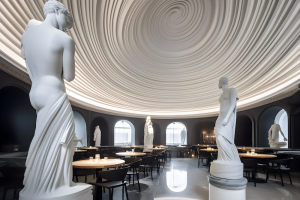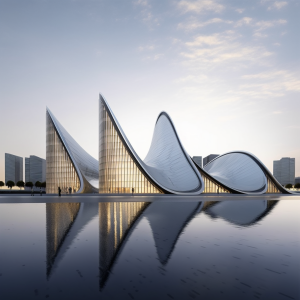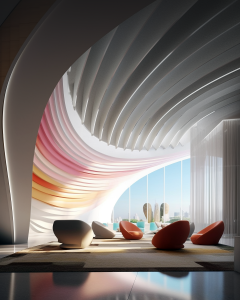Smriti Malhotra
Architects who once used to engage in the laborious task of sketching their designs whatever piece of paper they could get their hands on are now moving towards Artificial intelligence. Artificial intelligence tools can now produce thousands of design possibilities with just a few prompts. One such unique mind is that of architect designer Tim Fu. Tim Fu is a part of the Zaha Hadid Zaha Architects, the firm as we know is known for its innovative, cutting-edge and avant-garde designs. It goes without saying that the architects involved with the organisation will also be unconventional, much like the British-Iranian founder of the organisation, Zaha Hadid. The organisation has over 900 projects in over 40 countries and every project that Zaha Hadid Architects works on creates a dent in the contemporary world of architecture. In this article we shall be speaking about the emerging architect Tim Fu and delve into what inspires his works. He is utilising A.I. tools to generate design models and submerged his artistic sensibilities with artificial intelligence within his design and architectural practices.

Tim Fu specialises in algorithmic design and A.I research at the computational research group ZHACODE. He has collaborated with many international firms on A.I aided architectural design and has worked with A.I products and fashion brands. His A.I works have found a way within the art world, he recently exhibited at the Borders Art Fair during the Venice Biennale. His A.I explorations have been featured in Bloomberg, Architectural Digest, the Generative A.I Summit, etc. He is one of the first new generation architects that is pioneering the artificial intelligence module within the design and architecture realm.
In addition, he has hosted computational design workshops in various institutions including Harvard GSD, ACADIA, PA Academy and others. He is trying to push the boundaries of designing with his constant interest in artificial intelligence. He is leveraging the use of A.I technology in diverse contexts showcasing its versatility and adaptability in shaping the future of design.
Tim Fu usually begins his process by the conception of an idea, exploring that through A.I text prompting, then evolving the design, curating the results, fine tuning using artificial intelligence technology and then finaling processing everything post this process through Photoshop. He utilises various programs such as Midjourney, Dalle2, and stable diffusion. He is actively applying this technology in the design context, working on product design from vehicles,furniture, fashion to film set designs as well as websites.He has utilised his learnings of artificial intelligence into a broader field of designing and curation and constantly evolving as an architect and design curator.

As technology advances, architects such as Tim Fu play a vital role in shaping the future of the industry. They embrace the fairly unknown technology and learn it and use it as a tool for their own creations and innovative designs. While many believe that Artificial Intelligence can be disruptive and is moving so fast, it can easily overpower the end user. However in an interview with Sky News, a British Television News Channel, Tim Fu states that if one finds the right methodology to understand the algorithm, direct it well so that A.I doesn’t control the output but the user only curates the results.
He is heavily inspired by Zaha Hadid and her vision for design and technology, at ZHACODE, he is constantly trying to push boundaries within design and its construction in the spirit of constant innovation. He seeks his inspiration from the natural world looking at organic morphologies, geological formations, and an endless array of patterns in nature that could inspire a unique design language.

Tim Fu’s work within Zaha Hadid Architects showcases the growing influence of A.I within the design fraternity, he is creating endless design possibilities that are simply drawn from photographs of nature or text prompts generated by him. He represents the new-age architects that aren’t afraid of technological change but rather believes in embracing them and using those tools to create something new and exciting.





